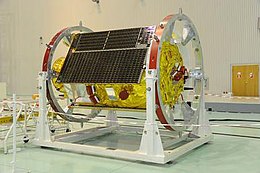EgyptSat 2
 |
|
| Mission type | Remote sensing |
|---|---|
| Operator | NARSS |
| COSPAR ID | 2014-021A |
| SATCAT no. | 39678 |
| Website | www |
| Mission duration | Planned: 11 years Final: 363 days |
| Spacecraft properties | |
| Bus | 559GK |
| Manufacturer | RSC Energia |
| Launch mass | 1,050 kilograms (2,310 lb) |
| Power | 3000 watts |
| Start of mission | |
| Launch date | April 16, 2014, 16:20 UTC |
| Rocket | Soyuz-U |
| Launch site | Baikonur 31/6 |
| End of mission | |
| Last contact | April 14, 2015 |
| Orbital parameters | |
| Regime | LEO |
| Perigee | 436 kilometres (271 mi) |
| Apogee | 703 kilometres (437 mi) |
| Inclination | 51.6 degrees |
| Period | 96.05 min |
| Epoch | 17 April 2014, 04:55 UTC |
| Main | |
| Name | EgyptSat 2 |
| Resolution | 1 metre (3 ft 3 in) (Pan) 4 metres (13 ft) (MS) |
| Images | |
|---|---|
|
|
|
| Video | |
|
|
|
|
|
EgyptSat 2 also called (MisrSat 2) is Egypt's second remote sensing Earth observation satellite built by the Russian RSC Energia and the Egyptian NARSS while the incorporated cameras and payload was developed by OAO Peleng and NIRUP Geoinformatsionnye Sistemy in Belarus.
A frameless spacecraft had been utilized in EgyptSat 2, as it is an innovative technology being first time used in Russia.
EgyptSat 2 was launched on board a Soyuz-U rocket on 16 April 2014 from the Baikonur Cosmodrome which was a milestone toward establishing the Egyptian Space Agency.
EgyptSat 2 was planned to be launched in October 1, 2013 but the launch was put on hold on 2011 following all contact being lost with EgyptSat 1 due to a failure of its S-Band communication system.
In 2007, Egypt made its first attempt to launch a high-resolution surveillance satellite launching the Ukrainian-made EgyptSat 1, but the satellite failed prematurely after 3 years, However, Egypt continued working with Yuzhnoye Design Bureau for the next project, until it received a bid from Russia to supply a state-of-the-art "eye in the sky". Negotiations lasted for more than four years until Egypt awarded the contract to Russia for the development of a high-resolution imaging satellite.
The project was handled by RKK Energia based on Korolev on the behalf of Russia, codenamed "E-Star". 60 percent of the satellite's hardware was made by Egypt. Russia also trained Egyptian engineers to control the satellite from a ground station near Cairo. The cost of the project is rumored to be around 40 million dollar fully funded by the Egyptian Armed Forces.
...
Wikipedia
